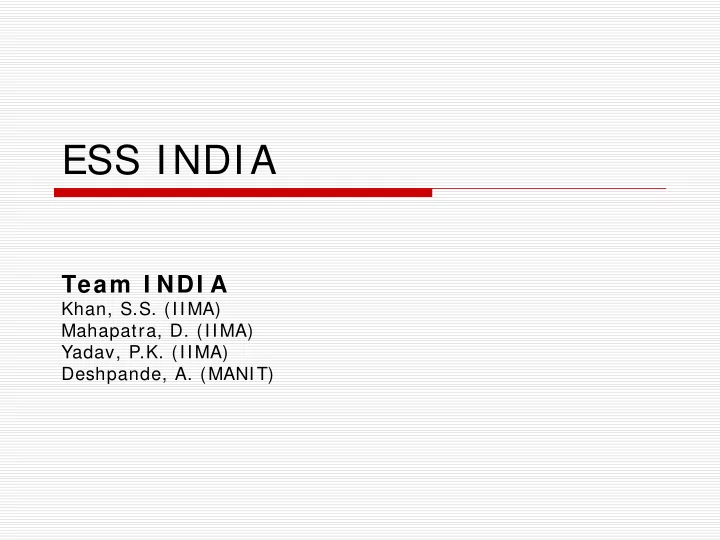

ESS INDIA Team I NDI A Khan, S.S. (IIMA) Mahapatra, D. (IIMA) Yadav, P.K. (IIMA) Deshpande, A. (MANIT)
Scenario Sustainable (2050) ‘A progressive society w hich is rapidly grow ing, inclusive as w ell as urbanized and sim ultaneously addresses the concerns of intergenerational equity and critical natural capital’ Societal Mindset Individualistic but conscious Allocation of Time Life revolves around work Consumption Behavior High but sensitized to intergenerational equity Housing Preference Multi dwelling housing structure Average Floor Space Increase Economic Status Reasonable growth rates Industrial Structure Led by tertiary sector International Relationships Selective and Trade Education Complete literacy, Strengthened school and higher education system Population Slow down in growth rate, Decline in family size Urban Profile 60% Urbanization, Balanced, Compact city structure, Public transport priority, Efficient corridors, EE Technologies, Critical natural resource protection.
Scenario Sustainable (2050) Keywords Index Base Target Grounds for the parameter Year Year Housing Share of X% 0.5X% Larger urbanized population with a compact city Preference detached development is expected to reduce the share of house detached houses 35 m 2 60 m 2 12 m 2 per capita (Planning standard, India) * 4 Floor Space Houses (Household Size Expected) + 25% Offices 8.6 b 37.36 b High urbanization and high employment in secondary m 2 m 2 and tertiary sectors Real GDP 2000 B 18801 445856 7% Average Rs. GDP Share P/ S/ T 22/ 27/ 15/ 25/ 60 High urbanization and tertiary sector driving change 51 Population 1.028 1.658 UN Medium Variant (Billion) No. of 192 473 / 3.5 Higher population / Urbanization leading to reduction households / 5.3 in family size (mil)/ Average family members Urban Population 30% 55% Forecasts Energy Access 55% 90% Govt vision for complete access by 2020
Scenario Aggressive (2050) Societal Mindset Individualistic Allocation of Time Life revolves around work Consumption Behavior High Housing Preference Multi dwelling housing structure Average Floor Space Increase Economic Status High growth rates Industrial Structure Secondary and tertiary sectors having equal priority and increase rapidly International Relationships Open and Trade Education Complete literacy, Strengthened school and higher education system Population Slow down in growth rate, Decline in family size Urban Profile 70% Urbanization, Focused Growth, Multimodal transport characteristics, Efficient corridors
Scenario Aggressive (2050) Keywords Index Base Target Grounds for the parameter Year Year Housing Share of X% 0.6X% Larger urbanized population is expected to reduce the Preference detached share of detached houses house 35 m 2 52 m 2 12 m 2 per capita (Planning standard, India) * 3.5 Floor Space Houses (Household Size Expected) + 25% Offices 8.6 b 50.7 b High urbanization and high employment in secondary m 2 m 2 and tertiary sectors Real GDP 2000 B 18801 615722 8% Average Rs. GDP Share P/ S/ T 22/ 27/ 5/ 30/ 65 High urbanization and tertiary sector driving change 51 Population 1.028 1.978 UN high variation (Billion) No. of 192 565 / 3.5 Higher population / Urbanization leading to reduction households / 5.3 in family size (mil)/ Average family members Urban Population 30% 60% Forecasts Energy Access 55% 90% Govt vision for complete access by 2020
Results: Residential CO 2 Emissions Factor Analysis Total '/C /D /E D C C E 2000% 1426% 1443% 1500% 970% 892% 1000% 575% vs 2000's 500% 126% 0% -500% -720% -1000% -938% -1016% -1500% -1356% 2050 Aggressive 2050 Sustainable Energy Consumption
Results: Passenger Transport CO 2 Emissions Factor Analysis Total C'/C C/E E/D D 2500% 1985% 2000% 1500% 1236% vs 2000's 896% 1000% 392% 500% -9% -19% 0% -173% -500% -306% -312% -434% -1000% 2050 Aggressive 2050 Sustainable Energy Consumption
Results: Freight Transport CO 2 Emissions - 10 20 30 40 50 60 Factor Analysis 2000 Total C'/ C E/ D C/ E D 700% 2050 Aggressive (CM) 567% 600% 492% 500% 2050 Sust ainable (CM) 437% 400% vs 2000's COL OIL GAS BMS REN Heat H2 ELE 300% 250% 200% - 10 20 30 40 50 60 70 80 100% 2000 2% 0% -41% -100% -59% -68% 2050 Aggressive (CM) -92% -114% -200% 2050 Aggressive 2050 Sustainable 2050 Sustainable (CM) COL OIL GAS BMS REN Heat H2 ELE Energy Consumption
Results Total Total C'/C E/D C/E D 1000% 883% 800% 600% 472% 406% 400% vs 2000's 221% 137% 200% 117% 0% -200% -157% -302% -400% -335% -396% -600% 2050 Aggressive 2050 Sustainable
Results Primary Energy Consumption Secondary Energy Consumption (By Fuel) (Sectoral) 1,000 1,200 1,400 1,600 1,800 - 500 1,000 1,500 2,000 2,500 3,000 - 200 400 600 800 2000 2000 2050 Aggressive (CM) 2050 Aggressive (CM) 2050 Sustainable 2050 Sustainable (CM) (CM) Industrial Residential Commercial Trans. Prv. Trans. Frg. COL OIL GAS BMS NUC HYD REN
Results CO 2 Emissions CO2 Emissions (By Fuel) (Sectoral) - 500 1,000 1,500 2,000 - 500 1,000 1,500 2,000 2000 2000 2050 Aggressive 2050 Aggressive (CM) (CM) 2050 Sustainable 2050 Sustainable (CM) (CM) COL OIL GAS Industrial Residential Commercial Trans. Prv. Trans. Frg. Other
Thanks!!
Recommend
More recommend